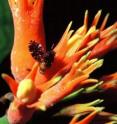More to biological diversity than meets the eye
Most of us already imagine the tropics as a place of diversity -- a lush region of the globe teeming with a wide variety of exotic plants and animals. But for researchers Andrew Forbes and Marty Condon, there's even more diversity than meets the eye. In a paper published in the March 14 issue of the journal Science, Forbes and Condon report the discovery of extraordinary diversity and specialization in the tropics.
Marty Condon, professor of biology at Cornell College, has been studying flies in the tropics for years and she reports evidence that there is more to a fly's ecological niche than where it lives and what it eats—you have to look at what eats the fly, as well.
The paper builds upon previous research conducted by Condon, who discovered surprising diversity while researching plant species in South America. Later, she, Forbes and their collaborators studied enemies of flies living on male and female flowers of the two closely related plants in a rainforest in Peru.
"We looked at species of flies and wasps on two rainforest plants and found more species than theory predicts we should have found," says Condon, lead researcher and corresponding author on the paper and professor of biology at Cornell College, Mount Vernon, Iowa.
"The reason so many species co-exist appears to be that each fly has a very specialized ability to escape all but one parasitic wasp species, and each wasp has a very specialized ability to kill one specific fly species. Specialized interactions between species allow more species to live in the same place," says Forbes, co-author and assistant professor of biology at the University of Iowa.
In particular, the researchers used genetic testing to discover a total of 14 fly species inhabiting the two plants, and 18 species of wasps that killed those flies.
"Most insects are specialists," Forbes says. "We have an idea that being a specialist should reduce the amount of overlap that you have with other species. So if you specialize in eating some plants, there shouldn't be lots of other similar insects eating the same plants. But we're finding lots and lots of fly species and lots and lots of parasitic wasp species in the same place.
"It's these interactions between plants, flies, and wasps that lead to far more diversity than we expect in this system," Forbes says. "Each fly can only be killed by one wasp, so when a fly moves into a new type of flower home it escapes that wasp. Eventually, the wasp might find it again, or a new wasp may evolve the ability to kill the fly.
"It's like a big game of hide and seek," he adds.
The wasps have trouble telling the flies apart and can lay eggs in the "wrong" species, which kill the wasp offspring before they hatch, improving the flies' ability to survive and reproduce.
"We wondered if the wasps laid their eggs in only one species. Is that the whole story?" Condon says. "No, it's not the whole story. It's a man bites dog story, because the wasp (the predators) will attack flies (the prey) that somehow are lethal to the wasp's offspring, which helped explain this pattern we were seeing."
"Insects are more diverse than we thought--they're ridiculously, extraordinarily diverse," Forbes says. "This study emphasizes how interactions between different species can help explain this diversity."
In addition to Condon and Forbes, researchers included: Sonja Scheffer and Matthew Lewis of the U.S. Department of Agriculture Systematic Entomology Laboratory, Beltsville, Md.; Robert Wharton of Texas A&M University, College Station, Texas; and Dean Adams of Iowa State University, Ames, Iowa.
The research was funded by grants from the National Science Foundation (NSF) and the University of Iowa.
Source: University of Iowa
Other sources
- More to biological diversity than meets the eye: Specialization by insect species is the keyfrom Science DailyFri, 14 Mar 2014, 9:31:55 UTC
- More to Biological Diversity Than Meets the Eyefrom Newswise - ScinewsThu, 13 Mar 2014, 18:30:53 UTC
- More to biological diversity than meets the eyefrom PhysorgThu, 13 Mar 2014, 18:00:20 UTC
